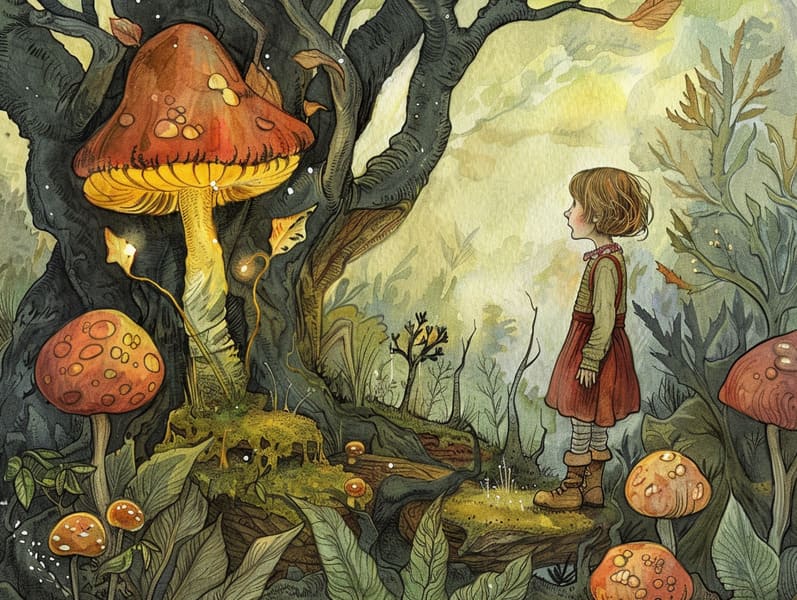
Old fairy tales have legendary status. These narratives have been recounted from one generation to the next centuries before they were ever recorded. They developed from a variety of backgrounds, including African traditions. They were initially narrated among grown-ups, often carrying themes and messages related to the societal norms and beliefs of the time.
The Brothers Grimm, Jacob and Wilhelm (the Grimm brothers), were among the first to collect and release many of these beloved tales. Their volume, "Grimm's Story Collection," included classics like "Cinder Maid," "Hansel and Gretel," and "Snow-White and Rose-Red," which have since become hallmarks in the world of classic fairy tales. Similarly, Hans Andersen's fantastical fairy tales, such as "The Mermaid's Tale," and "The Story of the Ugly Duckling," have won hearts worldwide, cementing their place in the pantheon of treasured fairy tales.
Even though they are old, these tales remain as pertinent as ever, especially as kids' bedtime tales. These magical stories are now available in multiple formats, including gorgeously illustrated books, magical animations, and digital fairy tales.
Their lasting presence can be connected to several delightful features:
Key Lessons: Ancient fairy tales often teach important moral lessons. Fairy tales like "The Shepherd Boy and the Wolf" teach the value of being truthful, while "The Race of the Tortoise and the Hare" point out the virtues of steadfastness and modesty. These tales offer young readers clear distinctions between ethical and unethical, shaping their moral compass in a soft yet impactful way.
Empathy and Understanding: Traditional fairy tales frequently showcase heroes facing tests and troubles, encouraging readers to identify with their struggles and rally behind their triumphs. For instance, "The Story of Beauty and the Beast" conveys the virtue of seeing beyond looks to acknowledge the real person of a being, nurturing kindness and understanding.
Cultural Insights: Many traditional fairy tales are rooted in the cultural contexts from which they developed. Learning from these narratives can provide delightful insights into different societies, promoting a sense of cultural understanding and perception.
Imagination and Innovation: The supernatural elements in timeless fairy tales—mythical entities—spark children’s dreams. These fairy tales carry readers to fantastical realms, stimulating fantasy-filled thoughts and a sense of mystery that stays a lifetime.
Classic fairy tales are not only delightful but also informative. They provide fascinating tools in advancing various cognitive and affective skills in young readers. When timeless fairy tales are spoken out loud, they improve speech development by teaching new lexicon and sophisticated sentence structures. This practice also fosters hearing perception and focus, as kids stay focused, eager to see what happens next.
Furthermore, exploring the themes and characters of ancient fairy tales can advance analytical skills and thinking skills. Young readers are shown to find patterns, expect results, and grasp cause and effect. These discussions also contribute to young ones speak out their thoughts and feelings, cultivating their emotional intelligence.
In today’s high-tech era, the availability of online fairy tales has made these stories more within reach than ever. Web-based platforms and mobile apps extend ample collections of Grimm's fairy tales that can be explored or listened via anytime, anywhere. Fairy tales narrated are particularly well-liked, providing an charming way for kids to take part in these enchanting tales. Audiobooks and read-aloud videos transport characters and settings to life, this site often supplemented by charming harmonies and harmonies that raise the tale-telling adventure.
The persistent attraction of classic fairy tales lies in their ability to adjust to modern times while preserving their core values. Contemporary modernizations of these narratives often integrate more multicultural characters and modern settings, making them accessible to today’s audience. However, the basic principles of heroism, generosity, and impartiality remain unchanged, continuing to influence audiences of all ages.
Fairy tales also offer a sense of peace and knowability. They extend a neat narrative with a definite beginning, middle, and end, often drawing to a close with the solving of conflicts and the triumph of good over bad. This steadiness can be reassuring for young ones, gifting a sense of steadiness in an fluctuating world.
Old fairy tales continue to fascinate and inform new generations, maintaining their grandeur and importance in modern society. As children's bedtime stories, they impart upon a perfect blend of magic and knowledge, fostering moral values, empathy, and creativity. The existence of web-based fairy tales and the widespread nature of fairy tales spoken ensure that these traditional fairy tales remain acquirable to new generations.
By preserving and broadcasting these narratives, we continue to extol the rich tapestry of human imagination and cultural heritage. Whether you are exploring a vibrantly illustrated book, perusing a online library, or hearing an narrated book, the wonder of children's fairy tales is always within reach. These tales emphasize of the invariable effect of storytelling and its ability to join us across generations and cultures.
If you are viewing a richly illustrated book, viewing a digital collection, or listening through an read-aloud book, the loveliness of traditional fairy tales is always within reach.
These stories convey of the steadfast nature of fairy tales and its ability to bind us across generations and cultures, establishing a link that charms and informs alike.